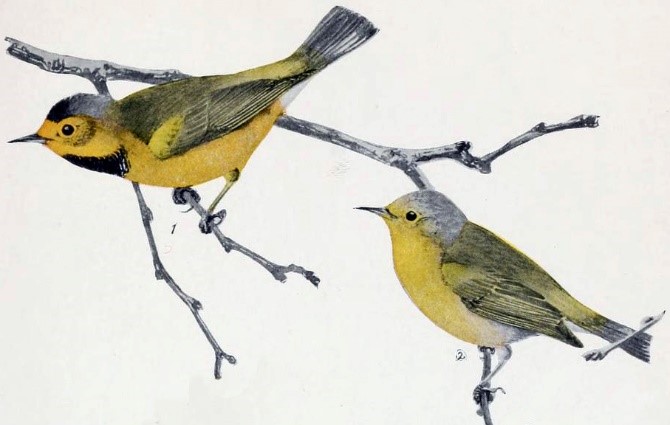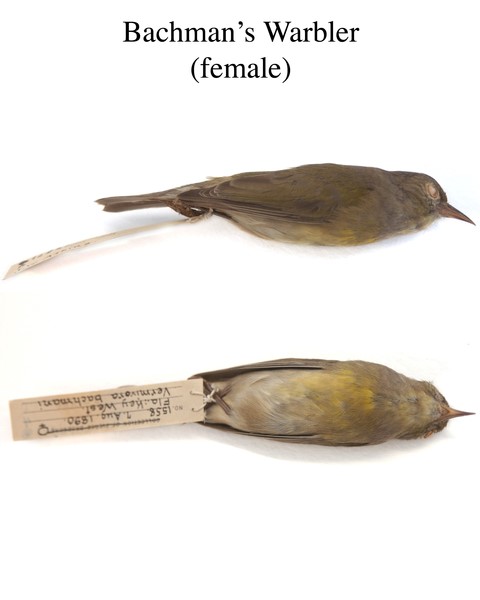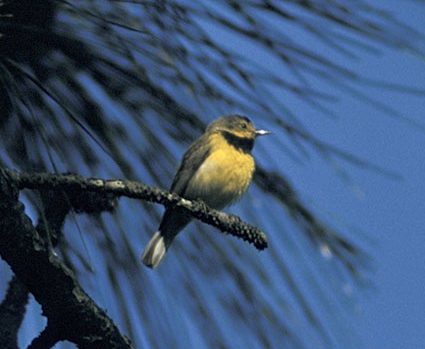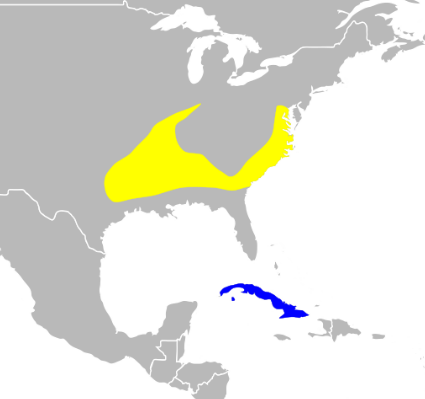Birdfinding.info ⇒ Until at least 1962, Bachman’s Warblers returned annually to the I’on Swamp in the Francis Marion National Forest northeast of Charleston, South Carolina (also the approximate site of its discovery to ornithology). The next forty years saw a sporadic trickle of reports from various quarters of its range: one more from the I’on Swamp in 1975; Louisiana in 1975 and 1988; Long County, Georgia in 1975; Brevard County, Florida on March 30, 1977 (inconclusively photographed); and Guardalavaca, Cuba on January 14, 2002 (reportedly filmed). Large-scale, systematic searches of likely breeding habitat throughout its range in the 1980s and 1990s were unsuccessful, leaving little room for hope that any members of the species have survived.
Bachman’s Warbler †
Vermivora bachmanii
Extinct. Formerly bred in the southeastern U.S. and wintered on Cuba.
Breeding. Primary nesting habitat was swamp forest, especially with canebrakes of the bamboo Arundinaria gigantea, in the bottomlands of the Mississippi River Valley from southern Illinois to Louisiana, on the coastal plains from eastern Texas and eastern Virginia to northern Florida; and in pockets of low-lying land elsewhere, including eastern Oklahoma.
Nonbreeding. Wintered all across Cuba, with isolated records from the Isle of Youth, Florida, and Georgia’s Okefenokee Swamp. On its wintering grounds it occupied various habitats, including dry forest, wetlands, and settled areas with flowering trees.
Movements. Migration evidently funneled through Florida, and was early in both directions, northbound mostly during March and southbound mostly during August.
Identification
A small olive-and-yellow warbler with a thin, decurved bill.
Male had yellow underparts, olive upperparts, a grayish crown with black forecrown and yellow forehead, and a prominent black bib.
Female was nondescript, mostly plain olive, sometimes showing a muted version of the male’s pattern.

Bachman’s Warbler, pair. (Illustration from The Warblers of North America by Frank M. Chapman, D. Appleton & Company, New York, 1907.) Louis Agassiz Fuertes

Bachman’s Warbler, male. (Museum specimen, UMMZ 163718, collected in Louisiana in 1891.) © Phil Myers

Bachman’s Warbler, female. (Museum specimen UMMZ 163715, collected in Florida in 1890.) © Phil Myers
Voice. Song was an even-toned, buzzy trill: Macauley Library recording from near Charleston, South Carolina in 1958. © G. Stuart Keith
Notes
Monotypic species.
IUCN Red List Status: Critically Endangered (Possibly Extinct).
Post-Mortem. Bachman’s Warbler was a habitat specialist that did not survive the European colonization of North America. The proximate cause of its decline is uncertain, and several candidate theories have been offered, especially the degradation of its breeding habitat. It also endured heavy losses on migration—evidenced by the deaths of at least 21 individuals striking the lighthouse at Sombrero Key, Florida, one night in March 1889. Contrasting the wide expanse of its breeding range against the focused vulnerability of the entire population on migration, it appears that the latter had far greater potential to reduce its numbers.
References
Alderfer, J., and J.L. Dunn. 2014. National Geographic Complete Birds of North America (Second Edition). National Geographic Society, Washington, D.C.
Avibirds.com. 2019. Bachman’s Warbler. https://avibirds.com/bachmans-warbler-extinct/. (Accessed November 7, 2019.)
BirdLife International. 2017. Vermivora bachmanii (amended version of 2016 assessment). The IUCN Red List of Threatened Species 2017: e.T22721607A119488270. http://dx.doi.org/10.2305/IUCN.UK.2017-3.RLTS.T22721607A119488270.en. (Accessed November 7, 2019.)
Curson, J., D. Quinn, and D. Beadle. 1994. Warblers of the Americas: An Identification Guide. Houghton Mifflin, Boston.
del Hoyo, J., N. Collar, and J.S. Marks. 2019. Bachman’s Warbler (Vermivora bachmanii). In Handbook of the Birds of the World Alive (J. del Hoyo, A. Elliott, J. Sargatal, D.A. Christie, and E. de Juana, eds.). Lynx Edicions, Barcelona. https://www.hbw.com/node/1344154. (Accessed November 7, 2019.)
Dunn, J.L., and K.L. Garrett. 1997. A Field Guide to Warblers of North America. Houghton Mifflin, Boston.
Garrido, O.H, and A. Kirkconnell. 2000. Field Guide to the Birds of Cuba. Cornell University Press, Ithaca, N.Y.
Hamel, P.D. 1986. Bachman’s Warbler: A Species in Peril. Smithsonian Institution Press, Washington, D.C.
Hamel, P.B., and S.A. Gauthreaux, Jr. 1982. The field identification of Bachman’s Warbler (Vermivora bachmanii Audubon). American Birds 36:235-240.
Hume, J.P. 2017. Extinct Birds (Second Edition). Bloomsbury Publishing PLC, London.
Raffaele, H., J. Wiley, O. Garrido, A. Keith, and J. Raffaele. 1998. A Guide to the Birds of the West Indies. Princeton University Press, Princeton, N.J.
U.S. Fish & Wildlife Service. 1998. Multi-Species Recovery Plan for South Florida: Bachman’s Warbler. https://www.fws.gov/verobeach/MSRPPDFs/Bachmanswarbler.pdf.

